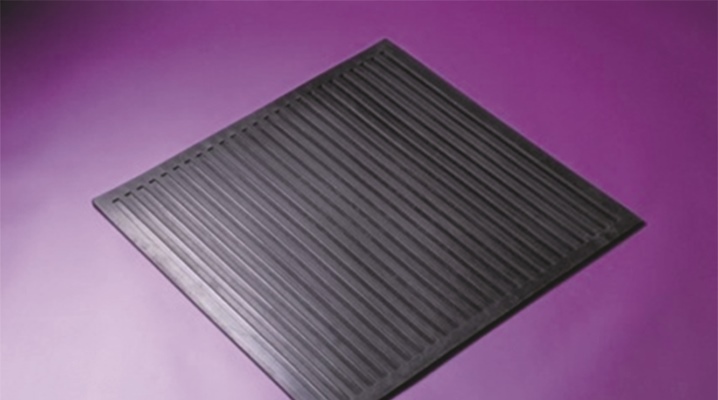Dielectric rugs test

Protection against electric shock is very important. For this purpose, specialized equipment and accessories can be used. Therefore, it is important to know the nuances of testing dielectric rugs.
Peculiarities
Dielectric mats are tested by visual inspection.

This procedure is primarily aimed at finding all deformations that interfere with the normal operation of the device.
Various problems are likely that deprive the product of its protective properties. According to technical standards, the facial area should not contain:
- cracks;
- holes;
- notches;
- protective thinning;
- foreign inclusions of any kind;
- inhomogeneity of thickness;
- 6 and more shells, the depth of which exceeds 1 mm;
- at least one bulge if the height is more than 1 mm and the diameter is larger than 4 mm.



But requirements are imposed on the surface and on the reverse side. They look for shells with a depth of more than 1.5 mm, a length of more than 35 mm, and a width of more than 20 mm. It is also necessary to look for bulges with a height of 1.6 mm or more, a diameter of 5.1 mm or more.
It is enough to exceed at least one indicator for the deviation to be recognized as critical for safety.
The presence of 6 or more abnormal places per meter of length is unacceptable; the electrical characteristics of the rugs are additionally checked.
A bend test is mandatory. Verification implies a single bend in two opposite directions by 180 degrees. This eliminates the cracking of the rugs. Any other mechanical defects are also unacceptable. The results of the checks are displayed in accompanying materials. And also they are entered in the company certificates of conformity for products.

How is it checked?
Operation of dielectric carpets that do not meet the standards of GOST 4997-75 is prohibited. The test is aimed at checking the suitability of products for indoor electrical installations and for open counterparts (but only in dry weather). The thickness should be strictly from 5 to 7 mm. Even a slight departure from these limits is prohibited. The length varies from 0.5 to 8 m and the width is from 0.5 to 1.2 m.

In the inspection protocols, the color is noted (there must be strictly one color) and the degree of corrugation of the front surface. The electrical test involves applying an alternating current with a frequency of 49.8 to 50.2 Hz. In this case, the temperature should be in the range from +15 to +35 degrees Celsius, and the relative humidity of the air from 45 to 75%.

Important: such a check in real production conditions can be carried out at least 6 hours after the end of rubber vulcanization. There are several verification options.
In the first version, the rugs are pulled between the steel rollers. The cross section of the shafts can be from 175 to 225 mm. In fact, the shafts are electrodes. The lower rotating member is grounded and forced to rotate. The movement speed can be from 2.7 to 3.3 cm per second.
The upper shaft is connected to a high-voltage current source. This element spins freely. The length of the electrodes is selected in such a way that the test takes place over the entire width, except for 5 cm from the extreme points. The value of the test voltage is 20,000 V. The points for removing the electrical voltage at the exit from the carpet are selected by engineers.

The second method of testing is valid only for carpets, the size of which is exactly 0.75x0.75 m. For work, use steel or cast iron baths. Water acts as a grounded electrode.The test specimen is placed so that its ends rise above the edges of the bath by about 5 cm. The second electrode is placed in the bath after pouring water onto the face of the mat. Its edges must be perfectly dry.

The start of the test is considered to be the supply of a current of 20,000 V. With this exposure, the mat must be kept for exactly 60 seconds. A maximum leakage current of 67 mA is allowed.


An alternative method is to place it between a pair of flat electrodes. The corners and sides of the electrodes are rounded off. The rounding radius exactly matches 50% of the electrode thickness.
The size of the electrodes is selected so that they do not reach the edges of the carpet from all sides by 0.05 m. It is permissible to use electrodes with an area smaller than the area of the carpet. Then testing is carried out throughout the entire volume of the product, excluding the impact on adjacent tested areas more than once. The industrial voltage current with a frequency of 50 Hz is systematically increased to 20,000 V within 60 seconds. Leakage current should not exceed 160 mA per sq. m.
Timing and frequency
Dielectric products are tested periodically in accordance with a schedule approved by the organization.
All protective equipment, including mats, must have special marks on the timing of the last inspection and testing.

The moment of checking and inspecting a dielectric carpet is marked on it in the form of a stamp. In the absence of such information, the use of protective devices is not permitted. Even if it does not cause problems, a fine may still be imposed.
The specific terms for performing such a procedure are prescribed in state standards and technical conditions. It is often asked - in what time frame it is necessary to test rubber mats. This point is not enshrined in regulatory enactments. However, an inspection is envisaged with the recording of the total in the documentation every year. An unmarked inspection must be carried out before each use to avoid accidents; if it is nevertheless necessary to test the products, then this is done according to the methods described above.


Regardless of the timing of practical testing, the product must withstand a large number of bends without losing its basic properties.
When storing the mat in a warehouse, all its parameters must remain unchanged for 3 years.
At any time, the product must withstand a voltage of 10,000 V per 1 sq. mm. The spacing between the grooved points is 1 to 3 mm. Old rugs are not allowed.
Where dielectric rugs are tested, see the video.








The comment was sent successfully.